inflation pressure TOYOTA YARIS 2020 Warranties & Maintenance Guides (in English)
[x] Cancel search | Manufacturer: TOYOTA, Model Year: 2020, Model line: YARIS, Model: TOYOTA YARIS 2020Pages: 260, PDF Size: 8.54 MB
Page 49 of 260
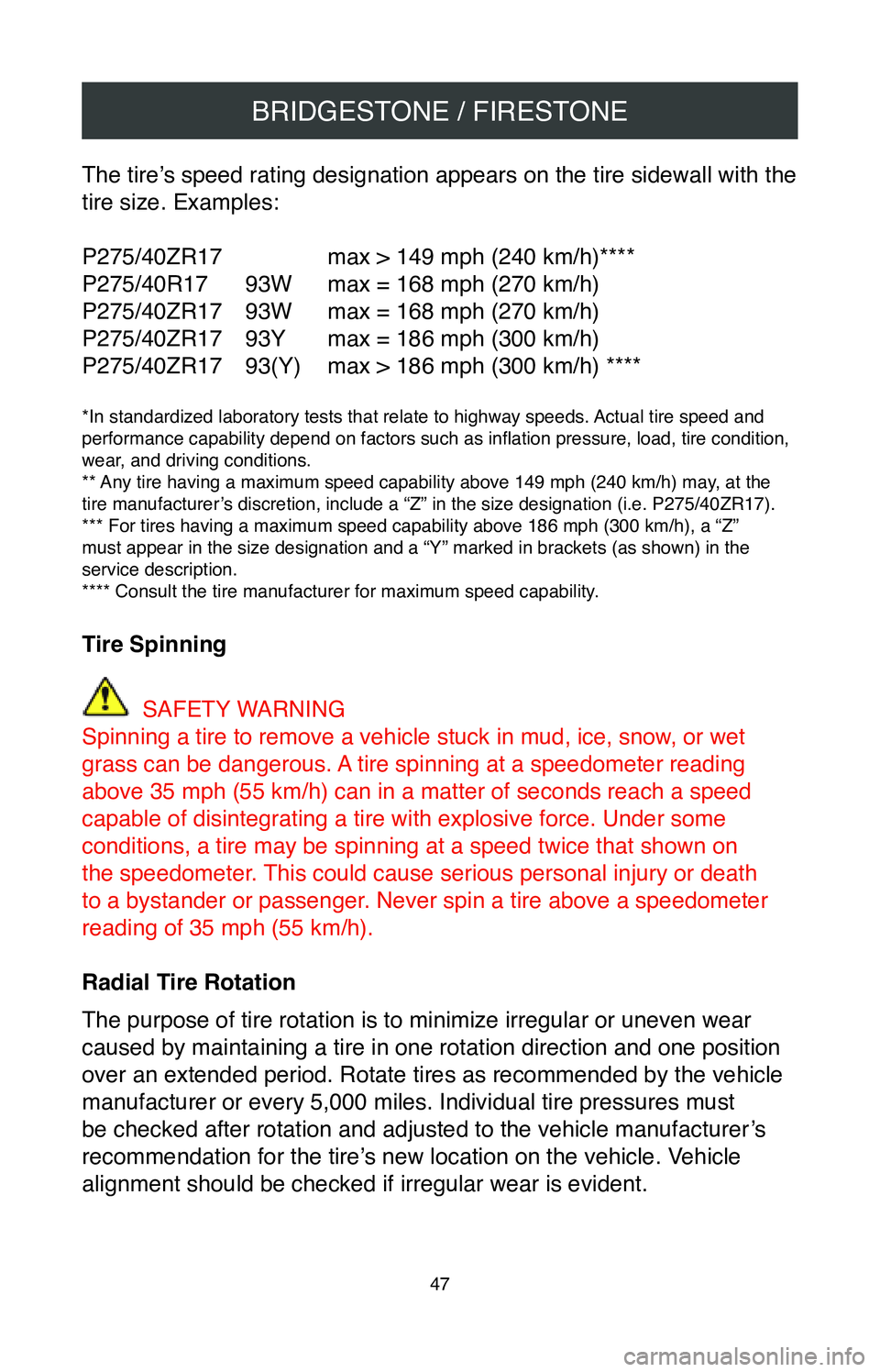
BRIDGESTONE / FIRESTONE
47
The tire’s speed rating designation appears on the tire sidewall with the
tire size. Examples:
P275/40ZR17
max > 149 mph (240 km/h)****
P275/40R17
93W max = 168 mph (270 km/h)
P275/40ZR17
93W max = 168 mph (270 km/h)
P275/40ZR17
93Y max = 186 mph (300 km/h)
P275/40ZR17
93(Y) max > 186 mph (300 km/h) ****
*In standardized laboratory tests that relate to highway speeds. Actual tire speed and
performance capability depend on factors such as inflation pressure, load, tire condition,
wear, and driving conditions.
** Any tire having a maximum speed capability above 149 mph (240 km/h) may, at the
tire manufacturer’s discretion, include a “Z” in the size designation (i.e. P275/40ZR17).
*** For tires having a maximum speed capability above 186 mph (300 km/h), a “Z”
must appear in the size designation and a “Y” marked in brackets (as shown) in the
service description.
**** Consult the tire manufacturer for maximum speed capability.
Tire Spinning
SAFETY WARNING
Spinning a tire to remove a vehicle stuck in mud, ice, snow, or wet
grass can be dangerous. A tire spinning at a speedometer reading
above 35 mph (55 km/h) can in a matter of seconds reach a speed
capable of disintegrating a tire with explosive force. Under some
conditions, a tire may be spinning at a speed twice that shown on
the speedometer. This could cause serious personal injury or death
to a bystander or passenger. Never spin a tire above a speedometer
reading of 35 mph (55 km/h).
Radial Tire Rotation
The purpose of tire rotation is to minimize irregular or uneven wear
caused by maintaining a tire in one rotation direction and one position \
over an extended period. Rotate tires as recommended by the vehicle
manufacturer or every 5,000 miles. Individual tire pressures must
be checked after rotation and adjusted to the vehicle manufacturer ’s
recommendation for the tire’s new location on the vehicle. Vehicle
alignment should be checked if irregular wear is evident.
Page 51 of 260
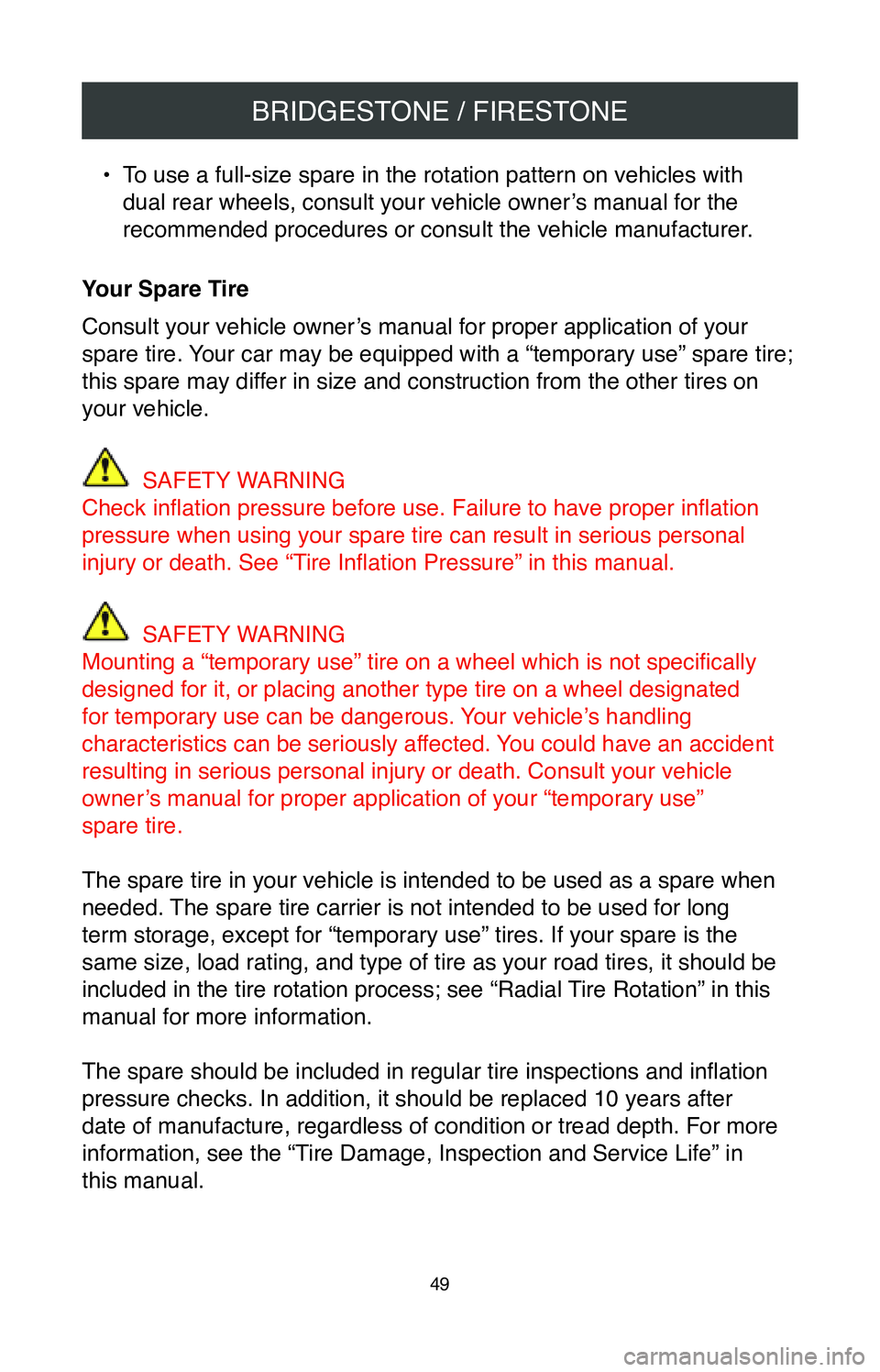
BRIDGESTONE / FIRESTONE
49
• To use a full-size spare in the rotation pattern on vehicles with
dual rear wheels, consult your vehicle owner’s manual for the
recommended procedures or consult the vehicle manufacturer.
Your Spare Tire
Consult your vehicle owner’s manual for proper application of your
spare tire. Your car may be equipped with a “temporary use” spare tire;
this spare may differ in size and construction from the other tires on
your vehicle.
SAFETY WARNING
Check inflation pressure before use. Failure to have proper inflation
pressure when using your spare tire can result in serious personal
injury or death. See “Tire Inflation Pressure” in this manual.
SAFETY WARNING
Mounting a “temporary use” tire on a wheel which is not specifically
designed for it, or placing another type tire on a wheel designated
for temporary use can be dangerous. Your vehicle’s handling
characteristics can be seriously affected. You could have an accident
resulting in serious personal injury or death. Consult your vehicle
owner’s manual for proper application of your “temporary use”
spare tire.
The spare tire in your vehicle is intended to be used as a spare when
needed. The spare tire carrier is not intended to be used for long
term storage, except for “temporary use” tires. If your spare is t\
he
same size, load rating, and type of tire as your road tires, it should b\
e
included in the tire rotation process; see “Radial Tire Rotation” in this
manual for more information.
The spare should be included in regular tire inspections and inflation
pressure checks. In addition, it should be replaced 10 years after
date of manufacture, regardless of condition or tread depth. For more
information, see the “Tire Damage, Inspection and Service Life” in
this manual.
Page 53 of 260
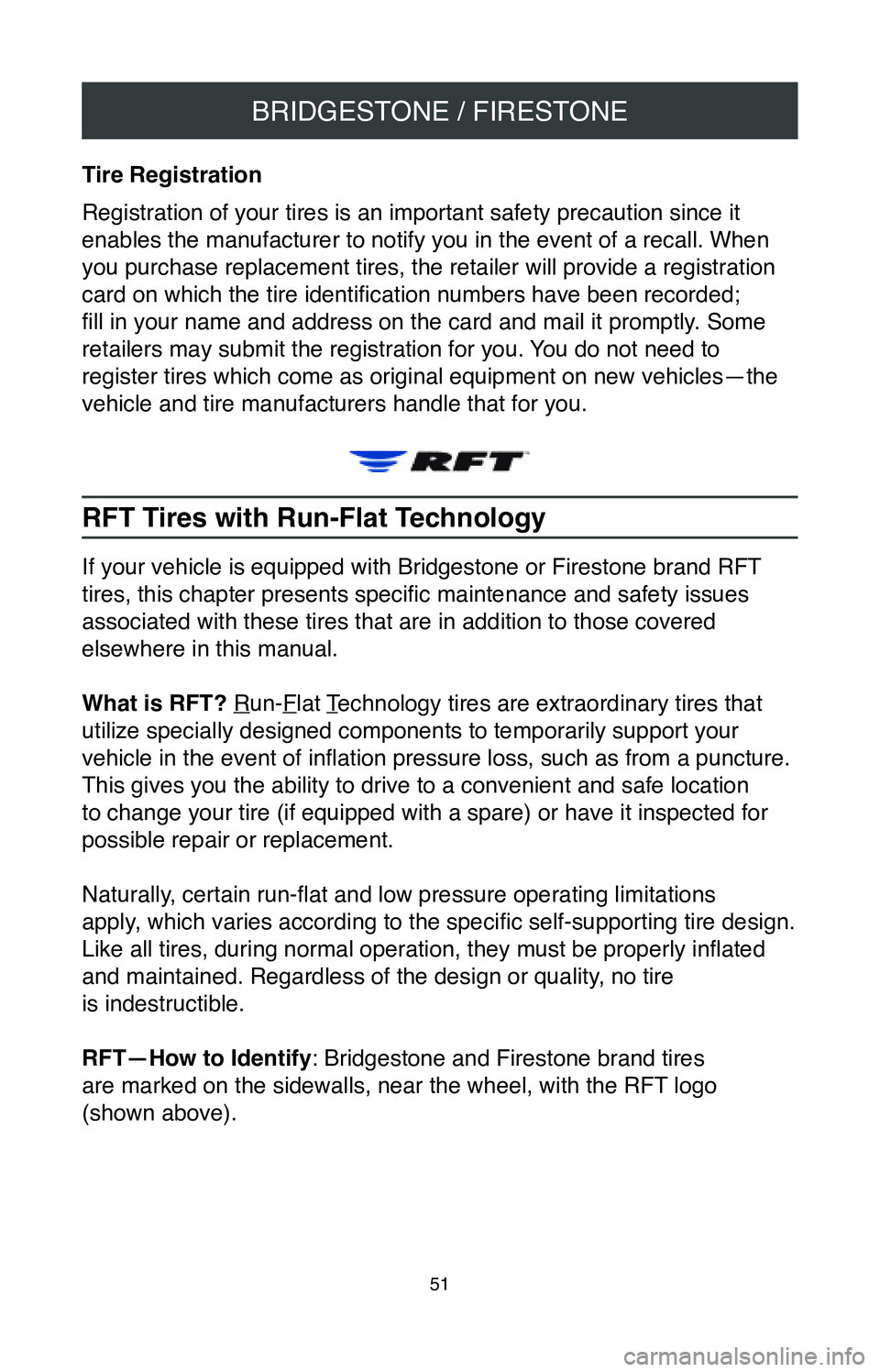
BRIDGESTONE / FIRESTONE
51
Tire Registration
Registration of your tires is an important safety precaution since it
enables the manufacturer to notify you in the event of a recall. When
you purchase replacement tires, the retailer will provide a registration\
card on which the tire identification numbers have been recorded;
fill in your name and address on the card and mail it promptly. Some
retailers may submit the registration for you. You do not need to
register tires which come as original equipment on new vehicles—the
vehicle and tire manufacturers handle that for you.
RFT Tires with Run-Flat Technology
If your vehicle is equipped with Bridgestone or Firestone brand RFT
tires, this chapter presents specific maintenance and safety issues
associated with these tires that are in addition to those covered
elsewhere in this manual.
What is RFT? Run-Flat Technology tires are extraordinary tires that
utilize specially designed components to temporarily support your
vehicle in the event of inflation pressure loss, such as from a puncture.
This gives you the ability to drive to a convenient and safe location
to change your tire (if equipped with a spare) or have it inspected for
possible repair or replacement.
Naturally, certain run-flat and low pressure operating limitations
apply, which varies according to the specific self-supporting tire design.
Like all tires, during normal operation, they must be properly inflated
and maintained. Regardless of the design or quality, no tire
is indestructible.
RFT—How to Identify : Bridgestone and Firestone brand tires
are marked on the sidewalls, near the wheel, with the RFT logo
(shown above).
Page 54 of 260
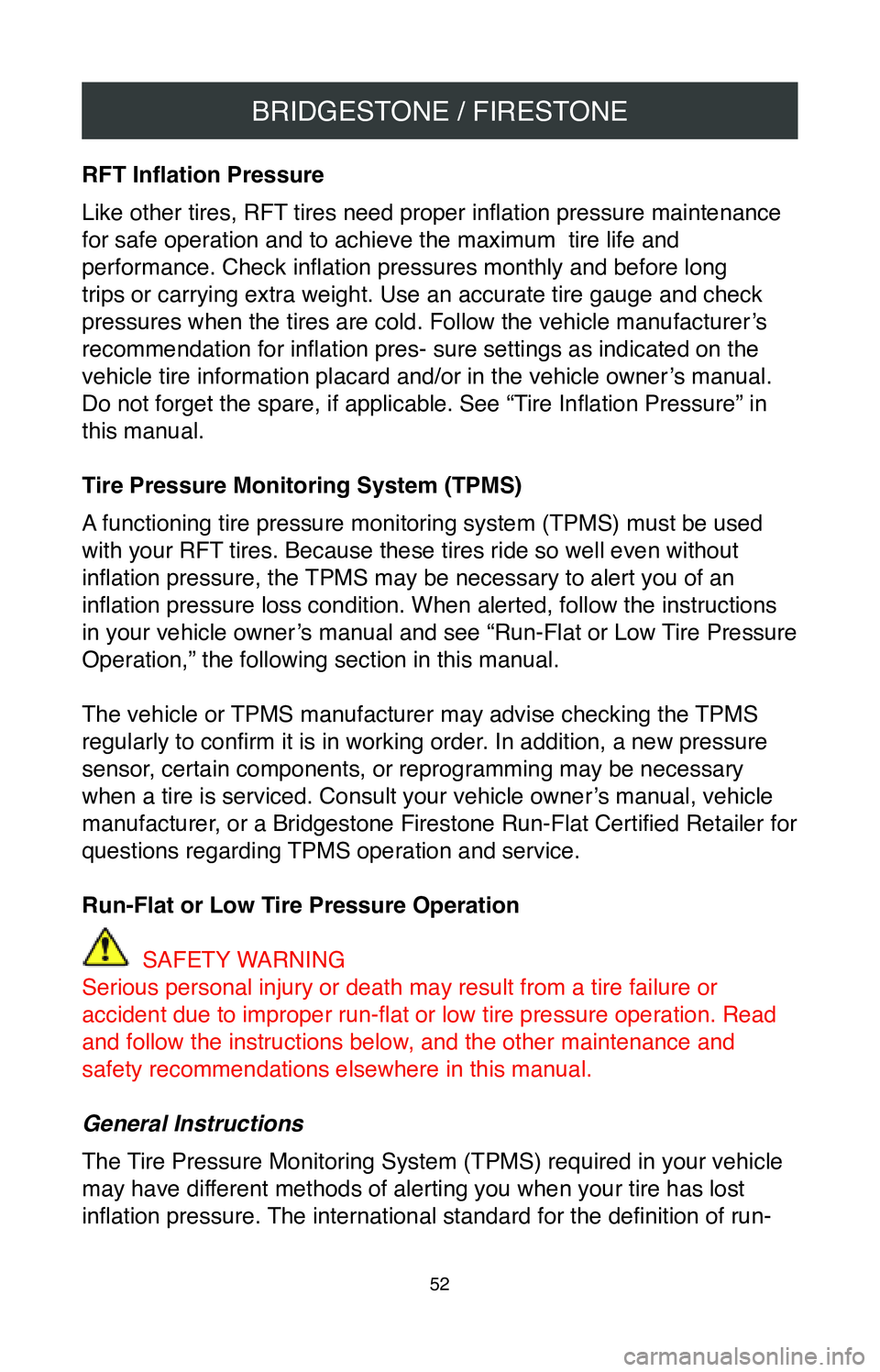
BRIDGESTONE / FIRESTONE
52
RFT Inflation Pressure
Like other tires, RFT tires need proper inflation pressure maintenance
for safe operation and to achieve the maximum tire life and
performance. Check inflation pressures monthly and before long
trips or carrying extra weight. Use an accurate tire gauge and check
pressures when the tires are cold. Follow the vehicle manufacturer’s
recommendation for inflation pres- sure settings as indicated on the
vehicle tire information placard and/or in the vehicle owner’s manual.
Do not forget the spare, if applicable. See “Tire Inflation Pressure” in
this manual.
Tire Pressure Monitoring System (TPMS)
A functioning tire pressure monitoring system (TPMS) must be used
with your RFT tires. Because these tires ride so well even without
inflation pressure, the TPMS may be necessary to alert you of an
inflation pressure loss condition. When alerted, follow the instructions
in your vehicle owner’s manual and see “Run-Flat or Low Tire Pressure
Operation,” the following section in this manual.
The vehicle or TPMS manufacturer may advise checking the TPMS
regularly to confirm it is in working order. In addition, a new pressure
sensor, certain components, or reprogramming may be necessary
when a tire is serviced. Consult your vehicle owner’s manual, vehicle
manufacturer, or a Bridgestone Firestone Run-Flat Certified Retailer for
questions regarding TPMS operation and service.
Run-Flat or Low Tire Pressure Operation
SAFETY WARNING
Serious personal injury or death may result from a tire failure or
accident due to improper run-flat or low tire pressure operation. Read
and follow the instructions below, and the other maintenance and
safety recommendations elsewhere in this manual.
General Instructions
The Tire Pressure Monitoring System (TPMS) required in your vehicle
may have different methods of alerting you when your tire has lost
inflation pressure. The international standard for the definition of run-
Page 55 of 260
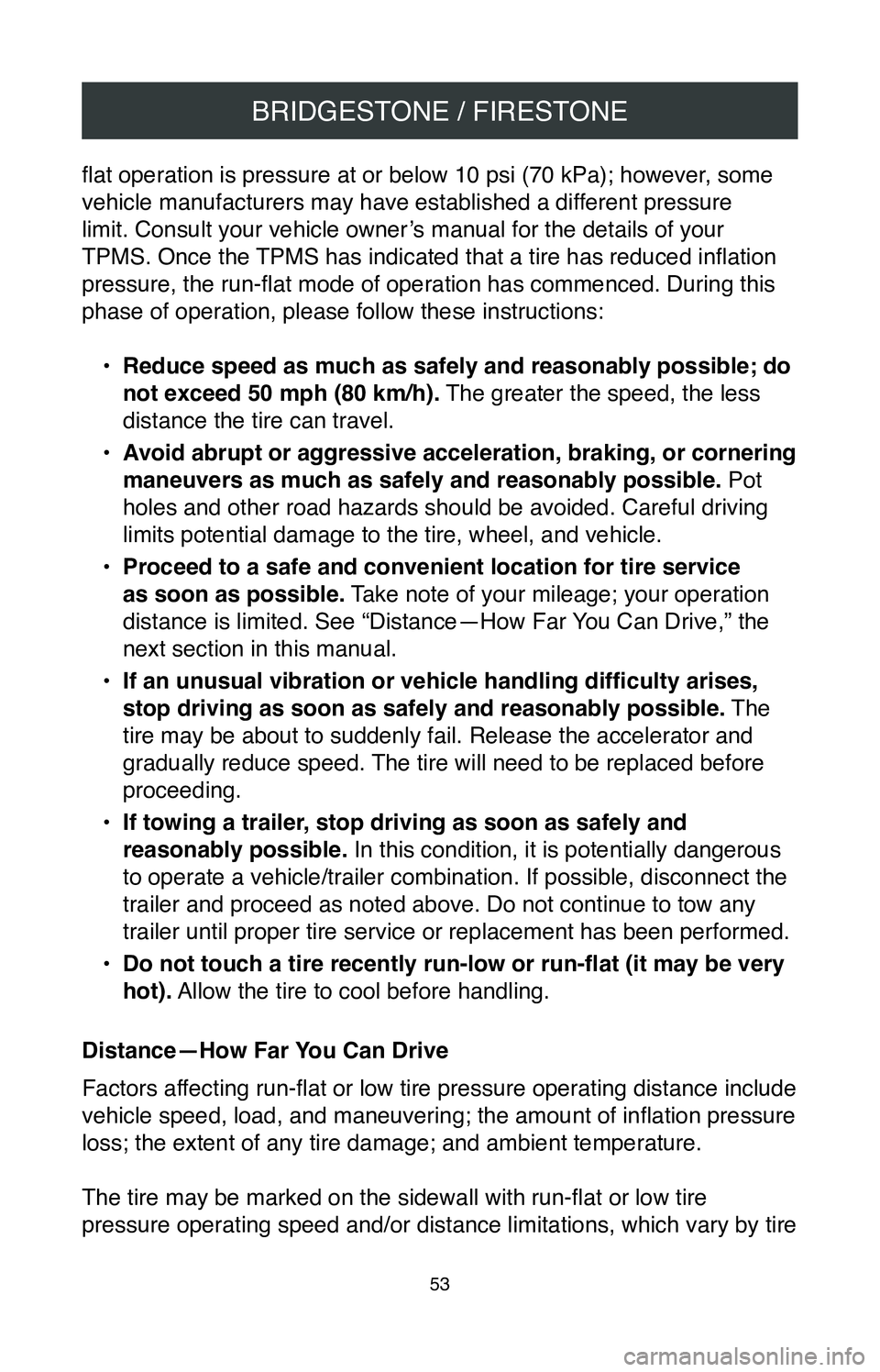
BRIDGESTONE / FIRESTONE
53
flat operation is pressure at or below 10 psi (70 kPa); however, some
vehicle manufacturers may have established a different pressure
limit. Consult your vehicle owner’s manual for the details of your
TPMS. Once the TPMS has indicated that a tire has reduced inflation
pressure, the run-flat mode of operation has commenced. During this
phase of operation, please follow these instructions:•
Reduce speed as much as safely and reasonably possible; do
not exceed 50 mph (80 km/h). The greater the speed, the less
distance the tire can travel.
•
Avoid abrupt or aggressive acceleration, braking, or cornering
maneuvers as much as safely and reasonably possible. Pot
holes and other road hazards should be avoided. Careful driving
limits potential damage to the tire, wheel, and vehicle.
•
Proceed to a safe and convenient location for tire service
as soon as possible. Take note of your mileage; your operation
distance is limited. See “Distance—How Far You Can Drive,” the
next section in this manual.
•
If an unusual vibration or vehicle handling difficulty arises,
stop driving as soon as safely and reasonably possible. The
tire may be about to suddenly fail. Release the accelerator and
gradually reduce speed. The tire will need to be replaced before
proceeding.
•
If towing a trailer, stop driving as soon as safely and
reasonably possible. In this condition, it is potentially dangerous
to operate a vehicle/trailer combination. If possible, disconnect the
trailer and proceed as noted above. Do not continue to tow any
trailer until proper tire service or replacement has been performed.
•
Do not touch a tire recently run-low or run-flat (it may be very
hot). Allow the tire to cool before handling.
Distance—How Far You Can Drive
Factors affecting run-flat or low tire pressure operating distance include
vehicle speed, load, and maneuvering; the amount of inflation pressure
loss; the extent of any tire damage; and ambient temperature.
The tire may be marked on the sidewall with run-flat or low tire
pressure operating speed and/or distance limitations, which vary by tire\
Page 57 of 260
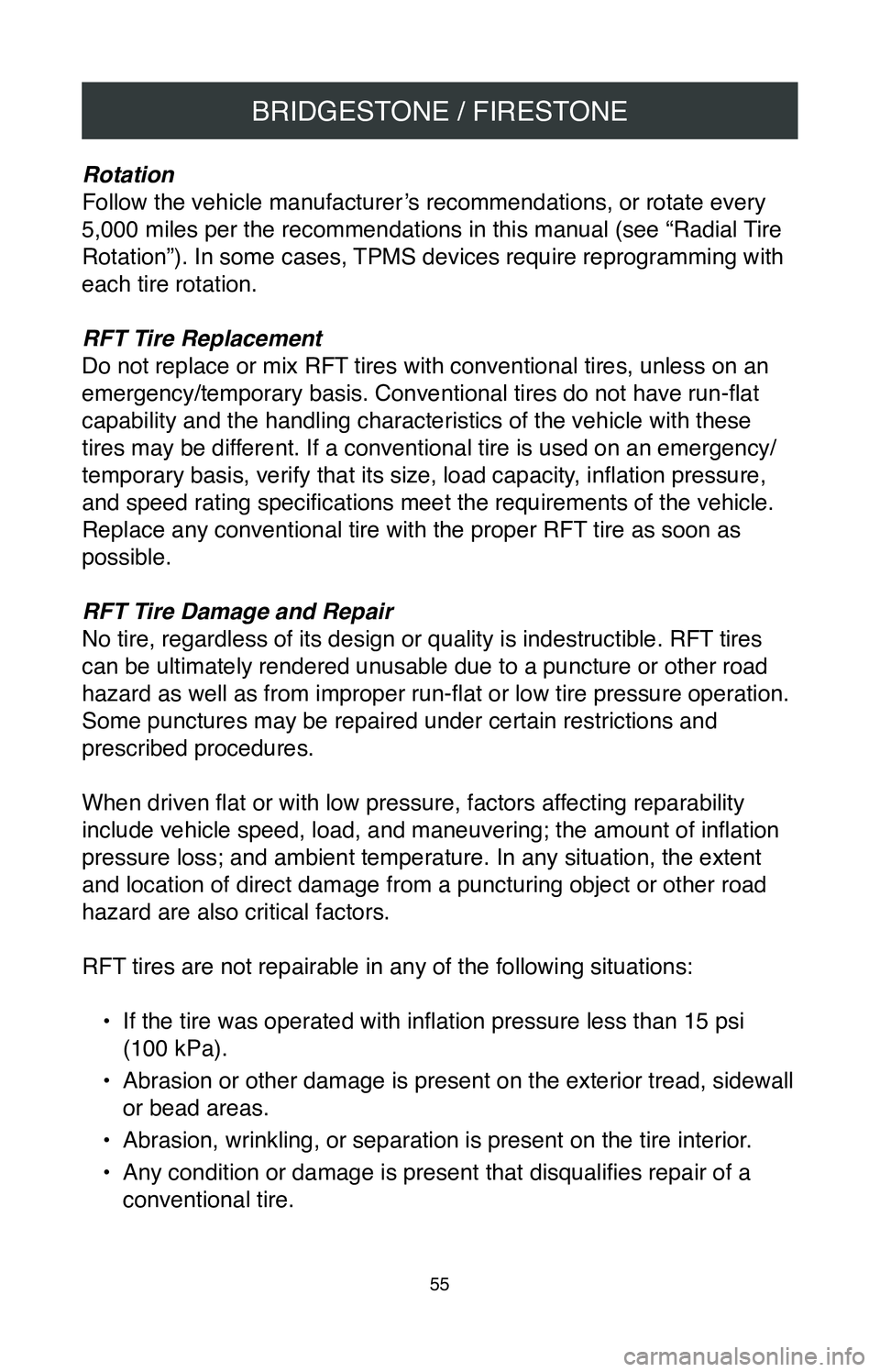
BRIDGESTONE / FIRESTONE
55
Rotation
Follow the vehicle manufacturer’s recommendations, or rotate every
5,000 miles per the recommendations in this manual (see “Radial Tire
Rotation”). In some cases, TPMS devices require reprogramming with
each tire rotation.
RFT Tire Replacement
Do not replace or mix RFT tires with conventional tires, unless on an
emergency/temporary basis. Conventional tires do not have run-flat
capability and the handling characteristics of the vehicle with these
tires may be different. If a conventional tire is used on an emergency/
temporary basis, verify that its size, load capacity, inflation pressure,
and speed rating specifications meet the requirements of the vehicle.
Replace any conventional tire with the proper RFT tire as soon as
possible.
RFT Tire Damage and Repair
No tire, regardless of its design or quality is indestructible. RFT tires
can be ultimately rendered unusable due to a puncture or other road
hazard as well as from improper run-flat or low tire pressure operation.
Some punctures may be repaired under certain restrictions and
prescribed procedures.
When driven flat or with low pressure, factors affecting reparability
include vehicle speed, load, and maneuvering; the amount of inflation
pressure loss; and ambient temperature. In any situation, the extent
and location of direct damage from a puncturing object or other road
hazard are also critical factors.
RFT tires are not repairable in any of the following situations:
•
If the tire was operated with inflation pressure less than 15 psi
(100 kPa).
•
Abrasion or other damage is present on the exterior tread, sidewall
or bead areas.
•
Abrasion, wrinkling, or separation is present on the tire interior.
•
Any condition or damage is present that disqualifies repair of a
conventional tire.
Page 60 of 260
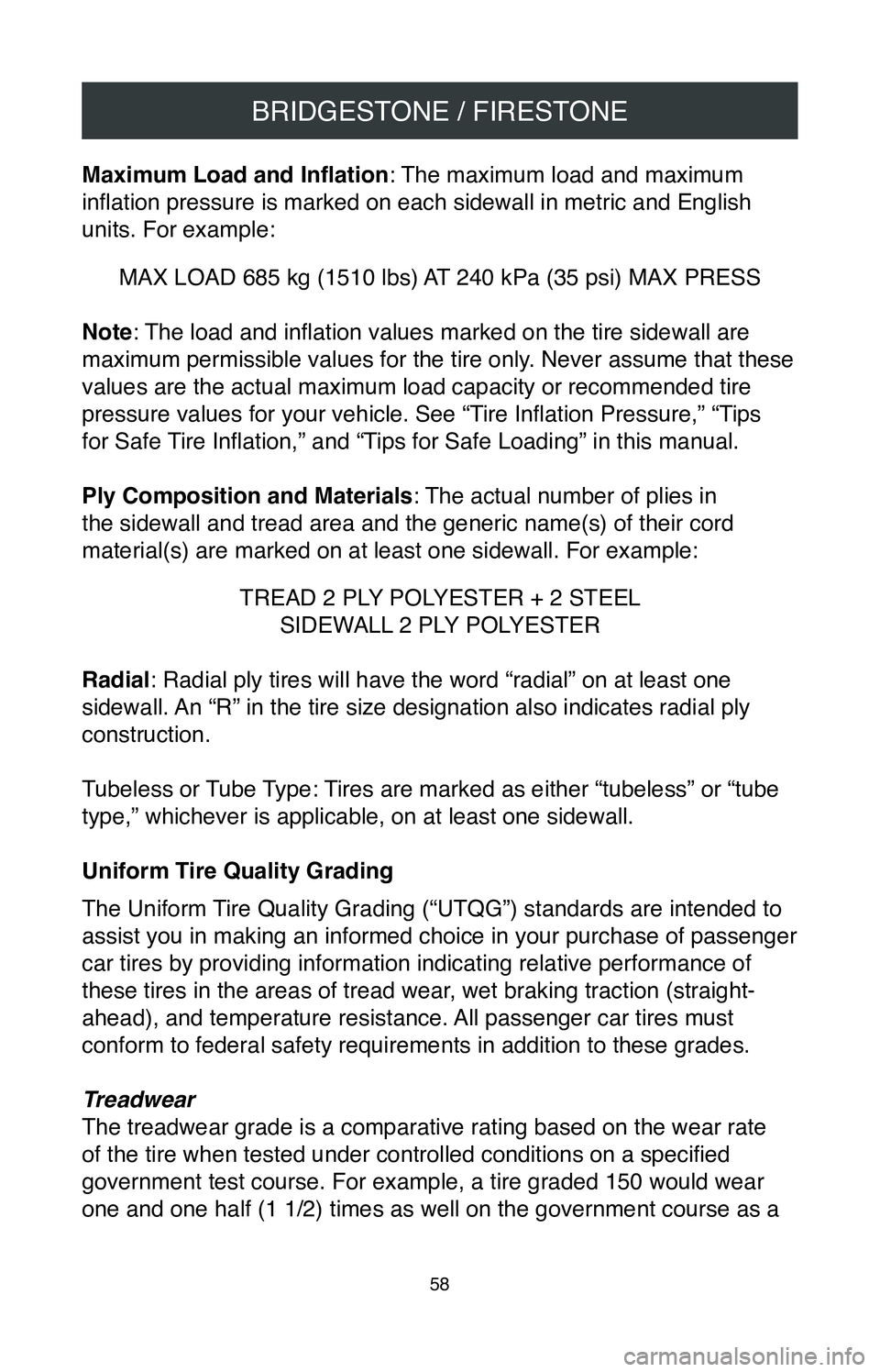
BRIDGESTONE / FIRESTONE
58
Maximum Load and Inflation: The maximum load and maximum
inflation pressure is marked on each sidewall in metric and English
units. For example:
MAX LOAD 685 kg (1510 lbs) AT 240 kPa (35 psi) MAX PRESS
Note: The load and inflation values marked on the tire sidewall are
maximum permissible values for the tire only. Never assume that these
values are the actual maximum load capacity or recommended tire
pressure values for your vehicle. See “Tire Inflation Pressure,” “Tips
for Safe Tire Inflation,” and “Tips for Safe Loading” in this manual.
Ply Composition and Materials : The actual number of plies in
the sidewall and tread area and the generic name(s) of their cord
material(s) are marked on at least one sidewall. For example:
TREAD 2 PLY POLYESTER + 2 STEEL SIDEWALL 2 PLY POLYESTER
Radial: Radial ply tires will have the word “radial” on at least one
sidewall. An “R” in the tire size designation also indicates radial ply
construction.
Tubeless or Tube Type: Tires are marked as either “tubeless” or “tube
type,” whichever is applicable, on at least one sidewall.
Uniform Tire Quality Grading
The Uniform Tire Quality Grading (“UTQG”) standards are intended to
assist you in making an informed choice in your purchase of passenger
car tires by providing information indicating relative performance of
these tires in the areas of tread wear, wet braking traction (straight-
ahead), and temperature resistance. All passenger car tires must
conform to federal safety requirements in addition to these grades.
Treadwear
The treadwear grade is a comparative rating based on the wear rate
of the tire when tested under controlled conditions on a specified
government test course. For example, a tire graded 150 would wear
one and one half (1 1/2) times as well on the government course as a
Page 63 of 260
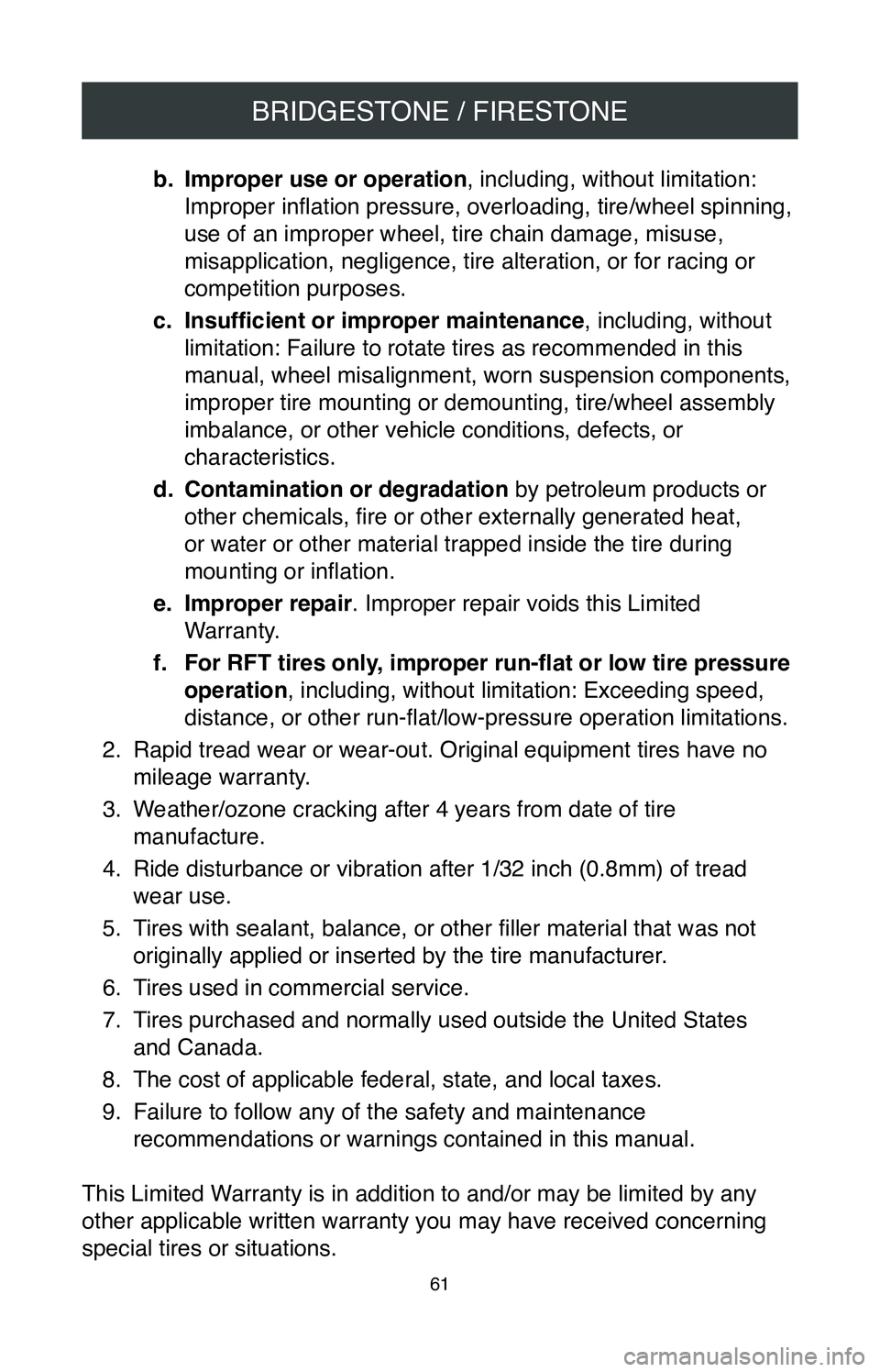
BRIDGESTONE / FIRESTONE
61
b. Improper use or operation, including, without limitation:
Improper inflation pressure, overloading, tire/wheel spinning,
use of an improper wheel, tire chain damage, misuse,
misapplication, negligence, tire alteration, or for racing or
competition purposes.
c.
Insufficient or improper maintenance , including, without
limitation: Failure to rotate tires as recommended in this
manual, wheel misalignment, worn suspension components,
improper tire mounting or demounting, tire/wheel assembly
imbalance, or other vehicle conditions, defects, or
characteristics.
d.
Contamination or degradation by petroleum products or
other chemicals, fire or other externally generated heat,
or water or other material trapped inside the tire during
mounting or inflation.
e.
Improper repair. Improper repair voids this Limited
Warranty.
f.
For RFT tires only, improper run-flat or low tire pressure
operation, including, without limitation: Exceeding speed,
distance, or other run-flat/low-pressure operation limitations.
2.
Rapid tread wear or wear-out. Original equipment tires have no
mileage warranty.
3.
Weather/ozone cracking after 4 years from date of tire
manufacture.
4.
Ride disturbance or vibration after 1/32 inch (0.8mm) of tread
wear use.
5.
Tires with sealant, balance, or other filler material that was not
originally applied or inserted by the tire manufacturer.
6.
Tires used in commercial service.
7.
Tires purchased and normally used outside the United States
and Canada.
8.
The cost of applicable federal, state, and local taxes.
9.
Failure to follow any of the safety and maintenance
recommendations or warnings contained in this manual.
This Limited Warranty is in addition to and/or may be limited by any
other applicable written warranty you may have received concerning
special tires or situations.
Page 65 of 260
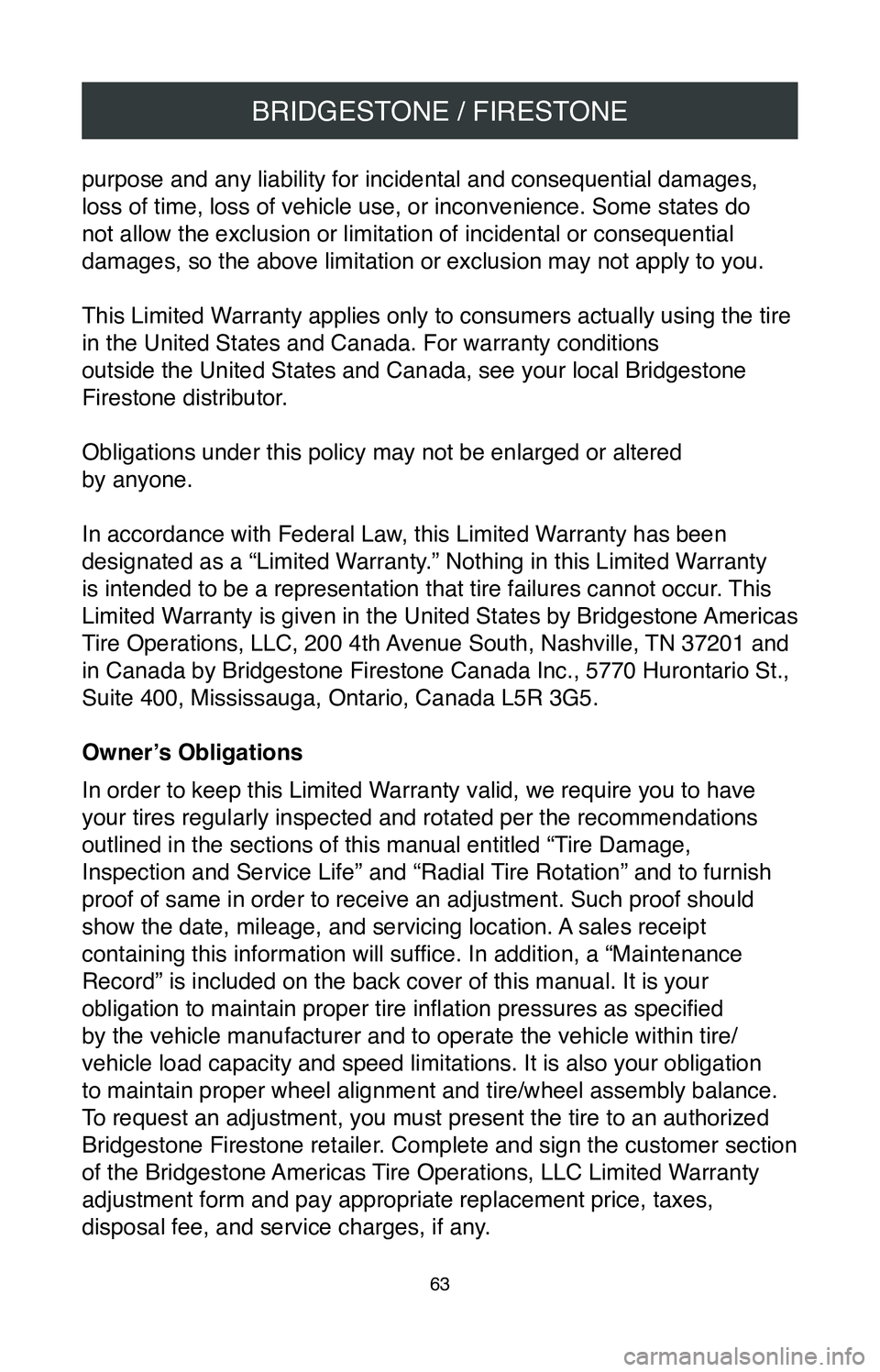
BRIDGESTONE / FIRESTONE
63
purpose and any liability for incidental and consequential damages,
loss of time, loss of vehicle use, or inconvenience. Some states do
not allow the exclusion or limitation of incidental or consequential
damages, so the above limitation or exclusion may not apply to you.
This Limited Warranty applies only to consumers actually using the tire
in the United States and Canada. For warranty conditions
outside the United States and Canada, see your local Bridgestone
Firestone distributor.
Obligations under this policy may not be enlarged or altered
by anyone.
In accordance with Federal Law, this Limited Warranty has been
designated as a “Limited Warranty.” Nothing in this Limited Warranty
is intended to be a representation that tire failures cannot occur. This
Limited Warranty is given in the United States by Bridgestone Americas
Tire Operations, LLC, 200 4th Avenue South, Nashville, TN 37201 and
in Canada by Bridgestone Firestone Canada Inc., 5770 Hurontario St.,
Suite 400, Mississauga, Ontario, Canada L5R 3G5.
Owner’s Obligations
In order to keep this Limited Warranty valid, we require you to have
your tires regularly inspected and rotated per the recommendations
outlined in the sections of this manual entitled “Tire Damage,
Inspection and Service Life” and “Radial Tire Rotation” and to furnish
proof of same in order to receive an adjustment. Such proof should
show the date, mileage, and servicing location. A sales receipt
containing this information will suffice. In addition, a “Maintenance
Record” is included on the back cover of this manual. It is your
obligation to maintain proper tire inflation pressures as specified
by the vehicle manufacturer and to operate the vehicle within tire/
vehicle load capacity and speed limitations. It is also your obligation \
to maintain proper wheel alignment and tire/wheel assembly balance.
To request an adjustment, you must present the tire to an authorized
Bridgestone Firestone retailer. Complete and sign the customer section
of the Bridgestone Americas Tire Operations, LLC Limited Warranty
adjustment form and pay appropriate replacement price, taxes,
disposal fee, and service charges, if any.
Page 71 of 260
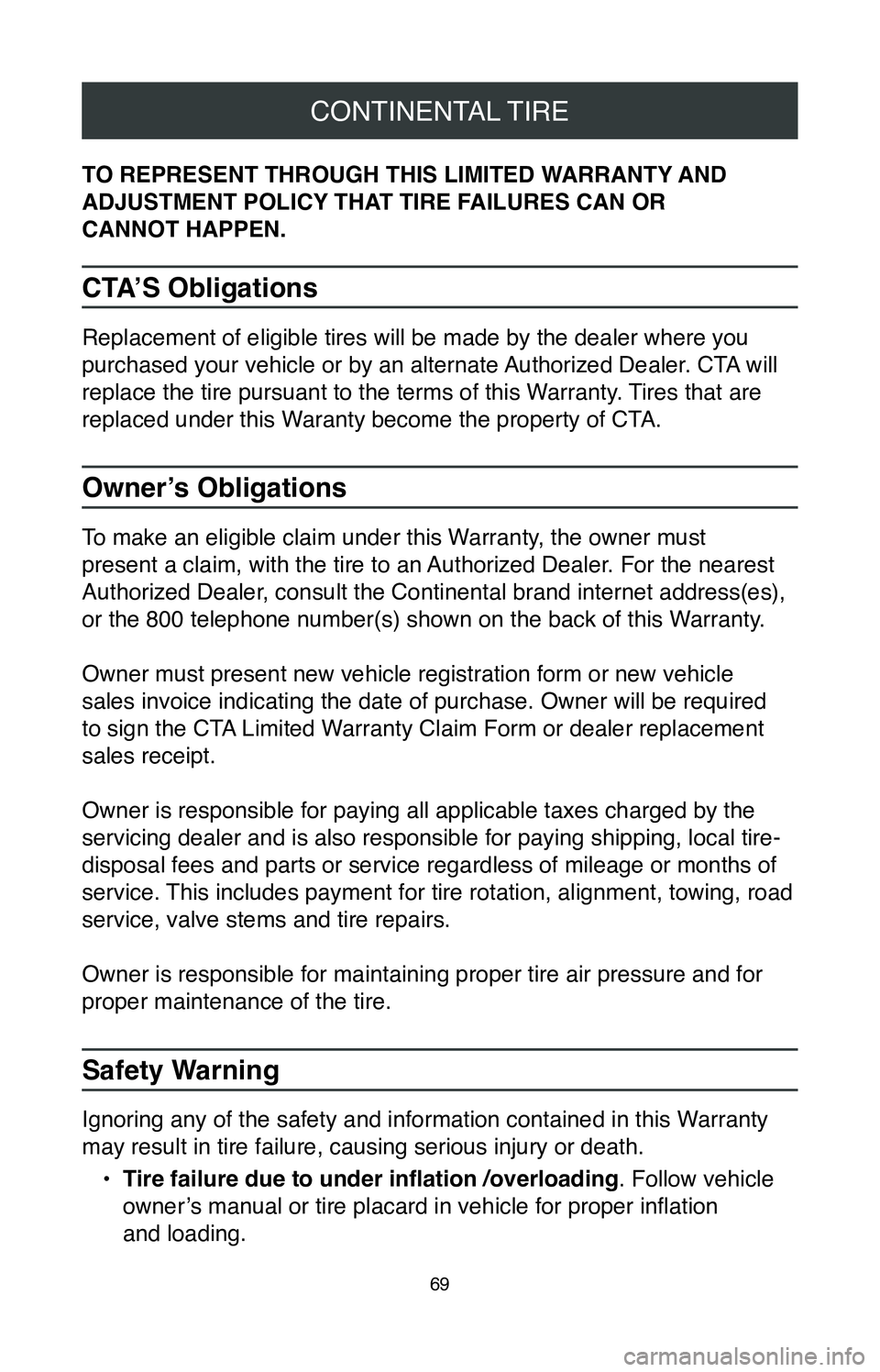
CONTINENTAL TIRE
69
TO REPRESENT THROUGH THIS LIMITED WARRANTY AND
ADJUSTMENT POLICY THAT TIRE FAILURES CAN OR
CANNOT HAPPEN.
CTA’S Obligations
Replacement of eligible tires will be made by the dealer where you
purchased your vehicle or by an alternate Authorized Dealer. CTA will
replace the tire pursuant to the terms of this Warranty. Tires that are
replaced under this Waranty become the property of CTA.
Owner’s Obligations
To make an eligible claim under this Warranty, the owner must
present a claim, with the tire to an Authorized Dealer. For the nearest
Authorized Dealer, consult the Continental brand internet address(es),
or the 800 telephone number(s) shown on the back of this Warranty.
Owner must present new vehicle registration form or new vehicle
sales invoice indicating the date of purchase. Owner will be required
to sign the CTA Limited Warranty Claim Form or dealer replacement
sales receipt.
Owner is responsible for paying all applicable taxes charged by the
servicing dealer and is also responsible for paying shipping, local tire-
disposal fees and parts or service regardless of mileage or months of
service. This includes payment for tire rotation, alignment, towing, road
service, valve stems and tire repairs.
Owner is responsible for maintaining proper tire air pressure and for
proper maintenance of the tire.
Safety Warning
Ignoring any of the safety and information contained in this Warranty
may result in tire failure, causing serious injury or death.•
Tire failure due to under inflation /overloading . Follow vehicle
owner’s manual or tire placard in vehicle for proper inflation
and loading.